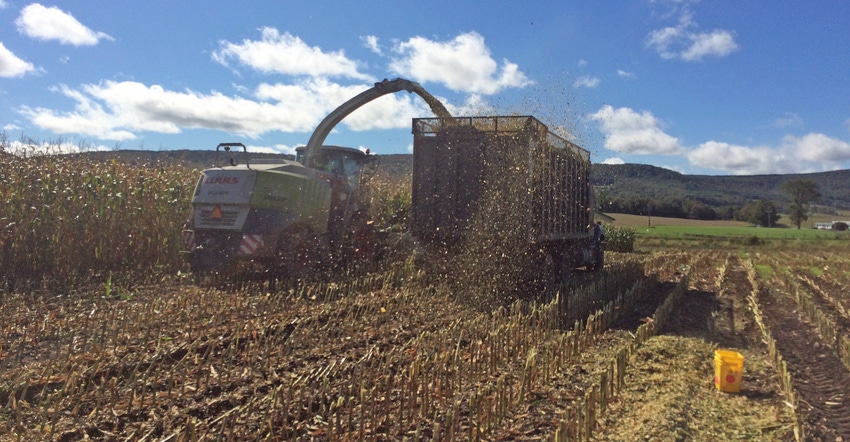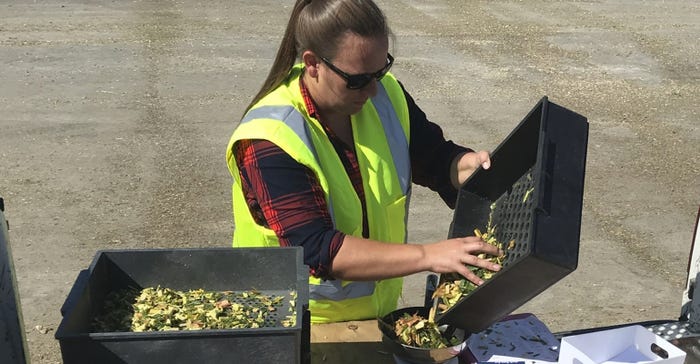July 19, 2022

Paying close attention to whole-plant dry matter, ear dry matter and corn silage processing score before harvest, along with monitoring the efficiency of kernel processing through harvest, can ensure production of high-quality corn silage.
And even though whole-plant dry matter of 35% is the optimal plant maturity for most forms of silage storage, trial data from Joe Lawrence, Cornell Pro-Dairy forage systems specialist, and Allison Kerwin, dairy field research specialist, shows that higher ear dry matter percentage is just as good an indicator of kernel maturity to guide both harvest timing and processing efficiency.
“Prior to the drydown process, a corn plant typically has whole-plant DM between 20% and 25%. During a normal drydown year without drought or frost impact, stover DM remains low relative to the ear DM,” Lawrence says in research funded by the New York Farm Viability Institute.
For example, during a year of abundant heat, Lawrence observed that ear dry matter increased quicker than stover dry matter.
“The healthy appearance of the corn that year hid the drier-than-expected corn and ears,” he says.
Cool, wet conditions the following year slowed plant maturation, making it difficult to reach the desired whole-plant dry matter of 35%. That year, stover added more to whole-plant dry matter than did ear dry matter.
“The combination of drier stover, comparatively low ear DM, and poor plant health often resulted in silage that was wetter than it visually appeared that year,” Lawrence says.
Data from a separate study for the New York & Vermont Corn Silage Hybrid Evaluation Program showed how quickly dry matter can change. That project recorded a jump in one week’s time of whole-plant dry matter from 32.4% to 37.2%, with starch content increasing from 30.7% to 35%, and tons-per-acre yield increasing from 20.4 to 23.1 (when adjusted to 35% DM).
“A significant amount of the yield increase was a result of the maturation of the kernels with more of the kernel milk converting into starch content [a 4.2% increase],” Lawrence says.
“Each grower needs to apply the best approach for individual farm conditions as the exact rate of drydown is influenced by growing environment each year. This research, however, demonstrates that with the accepted range of 32% to 38%, DM gains can be achieved by allowing your corn to reach a greater DM for harvest,” he adds.
Testing forage samples
“While laboratory analysis is still the gold standard for evaluating your processing success for the season, in-field monitoring provides guidance for quickly adjusting for any mechanical issues that may be inadequately processing forage,” Lawrence notes.
Low-cost ways to assess how well your crop is processing during harvest include use of the Penn State Particle Separator, the 32-ounce cup method, and the bucket and water test. Some farmers also “eyeball” the chop.
In addition to in-field testing, some farms have employees who regularly check samples at the bunk or silo.
If the testing is not producing your desired results, check your equipment’s rollers, pulley and belt system, and spring tension, which helps avoid roller bounce that reduces uniform kernel breakage.

CHECKING THE CHOP: Betsy Hicks, dairy specialist with the South Central New York Cornell Cooperative Extension Team, checks chopped silage as part of research to improve the production of high-quality corn silage.
Ninety percent of farmers surveyed by Lawrence and Kerwin reported adjusting the roller speed differential; 50% modified the belt and pulley system.
Differences due to growing conditions and location, in addition to hybrid selection, can affect how well the equipment processes a crop from year to year, making continual monitoring of the harvest a good way to maximize processing quality.
Importance of fermentation
While fermentation increases the digestibility of the starch, the cows’ ability to use that starch depends on its accessibility to the cow’s rumen microbes.
To assess the impact of fermentation on starch availability in the silage, Lawrence and Kerwin collected data at four points — zero, 45, 90 and 135 days — in the process and measured in-vitro starch digestibility in forage samples.
“Our evaluation produced no indication that fermentation time had a consistent effect on CSPS [corn silage processing score] as measured by forage lab analysis,” Lawrence says, adding that “this finding is specific to the fermentation process alone and was conducted in an environment where the silage was not subject to other factors that could affect particle size.”
Analysis of samples taken at harvest (zero days fermentation) suggested a 0.5% drop in starch digestibility for each 1-unit increase in whole-plant DM with a similar impact through 90 days. The level of impact decreases noticeably between 90 and 135 days ensiled, at which point starch showed an expected drop of 0.06% for each 1-unit increase in whole plant DM.
“Our analysis shows a trend over time that reinforces the industry guideline to allow corn silage to ferment for three to four months before feedout,” Lawrence says. “The lack of a relationship between fermentation time and changes in the CSPS in our study supports the importance of being within optimal processing score range at harvest.”
To learn more about this research, see the Kernel Processing Information Series of five fact sheets posted at cals.cornell.edu.
Dunn writes from her farm in Mannsville, N.Y.
About the Author(s)
You May Also Like




